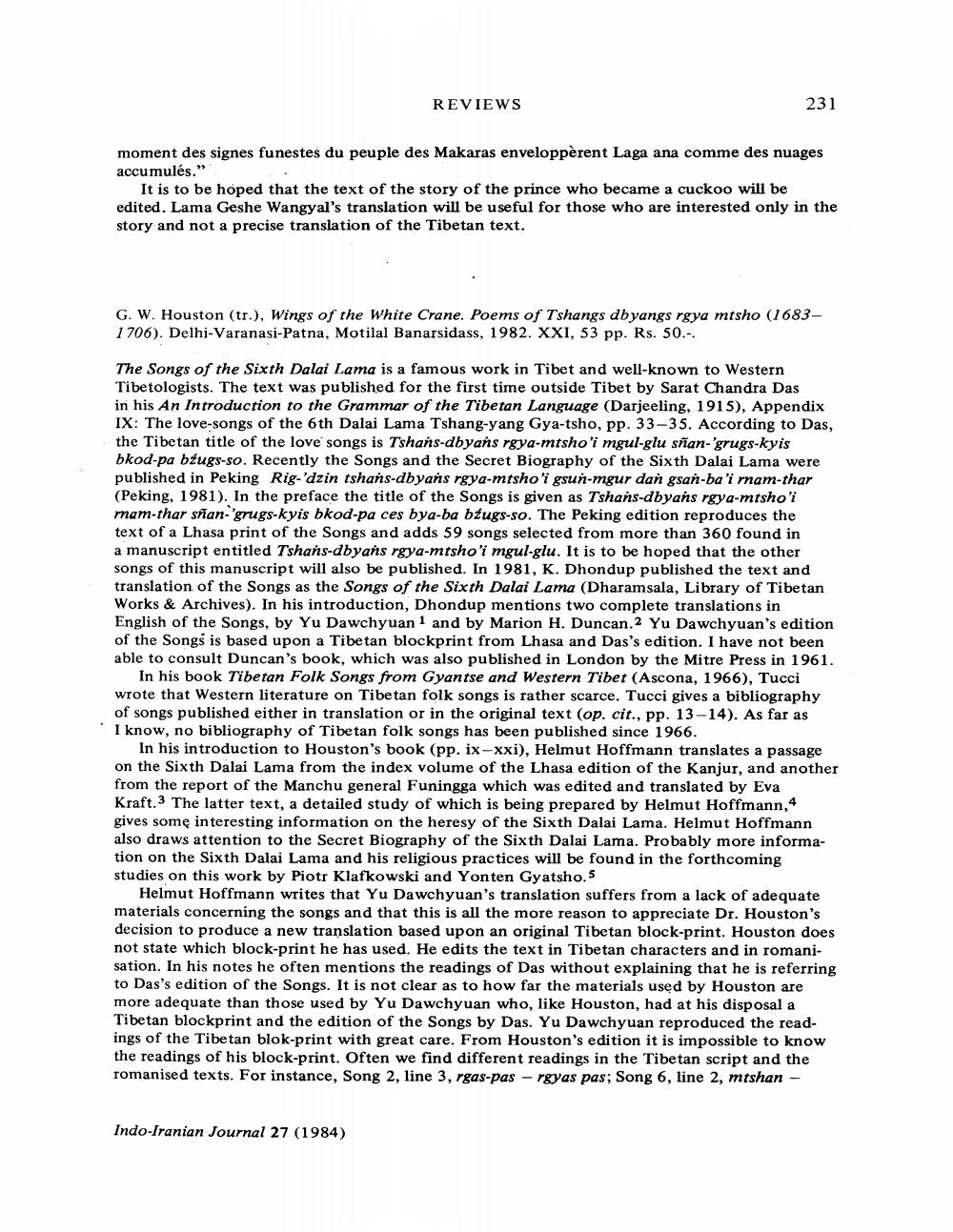________________
REVIEWS
231
moment des signes funestes du peuple des Makaras enveloppèrent Laga ana comme des nuages accumulés."
It is to be hoped that the text of the story of the prince who became a cuckoo will be edited. Lama Geshe Wangyal's translation will be useful for those who are interested only in the story and not a precise translation of the Tibetan text.
G. W. Houston (tr.), Wings of the White Crane. Poems of Tshangs dbyangs rgya mtsho (16831706). Delhi-Varanasi-Patna, Motilal Banarsidass, 1982. XXI, 53 pp. Rs. 50.-.
Indo-Iranian Journal 27 (1984)
The Songs of the Sixth Dalai Lama is a famous work in Tibet and well-known to Western Tibetologists. The text was published for the first time outside Tibet by Sarat Chandra Das in his An Introduction to the Grammar of the Tibetan Language (Darjeeling, 1915), Appendix IX: The love-songs of the 6th Dalai Lama Tshang-yang Gya-tsho, pp. 33-35. According to Das, the Tibetan title of the love songs is Tshans-dbyans rgya-mtsho'i mgul-glu sñan-'grugs-kyis bkod-pa bźugs-so. Recently the Songs and the Secret Biography of the Sixth Dalai Lama were published in Peking Rig-'dzin tshans-dbyans rgya-mtsho'i gsun-mgur dan gsan-ba'i rnam-thar (Peking, 1981). In the preface the title of the Songs is given as Tshans-dbyans rgya-mtsho'i mam-thar sñan-grugs-kyis bkod-pa ces bya-ba bźugs-so. The Peking edition reproduces the text of a Lhasa print of the Songs and adds 59 songs selected from more than 360 found in a manuscript entitled Tshans-dbyans rgya-mtsho'i mgul-glu. It is to be hoped that the other songs of this manuscript will also be published. In 1981, K. Dhondup published the text and translation of the Songs as the Songs of the Sixth Dalai Lama (Dharamsala, Library of Tibetan Works & Archives). In his introduction, Dhondup mentions two complete translations in English of the Songs, by Yu Dawchyuan 1 and by Marion H. Duncan.2 Yu Dawchyuan's edition of the Songs is based upon a Tibetan blockprint from Lhasa and Das's edition. I have not been able to consult Duncan's book, which was also published in London by the Mitre Press in 1961. In his book Tibetan Folk Songs from Gyantse and Western Tibet (Ascona, 1966), Tucci wrote that Western literature on Tibetan folk songs is rather scarce. Tucci gives a bibliography of songs published either in translation or in the original text (op. cit., pp. 13-14). As far as I know, no bibliography of Tibetan folk songs has been published since 1966.
In his introduction to Houston's book (pp. ix-xxi), Helmut Hoffmann translates a passage on the Sixth Dalai Lama from the index volume of the Lhasa edition of the Kanjur, and another from the report of the Manchu general Funingga which was edited and translated by Eva Kraft.3 The latter text, a detailed study of which is being prepared by Helmut Hoffmann,4 gives some interesting information on the heresy of the Sixth Dalai Lama. Helmut Hoffmann also draws attention to the Secret Biography of the Sixth Dalai Lama. Probably more information on the Sixth Dalai Lama and his religious practices will be found in the forthcoming studies on this work by Piotr Klafkowski and Yonten Gyatsho. 5
Helmut Hoffmann writes that Yu Dawchyuan's translation suffers from a lack of adequate materials concerning the songs and that this is all the more reason to appreciate Dr. Houston's decision to produce a new translation based upon an original Tibetan block-print. Houston does not state which block-print he has used. He edits the text in Tibetan characters and in romanisation. In his notes he often mentions the readings of Das without explaining that he is referring to Das's edition of the Songs. It is not clear as to how far the materials used by Houston are more adequate than those used by Yu Dawchyuan who, like Houston, had at his disposal a Tibetan blockprint and the edition of the Songs by Das. Yu Dawchyuan reproduced the readings of the Tibetan blok-print with great care. From Houston's edition it is impossible to know the readings of his block-print. Often we find different readings in the Tibetan script and the romanised texts. For instance, Song 2, line 3, rgas-pas-rgyas pas; Song 6, line 2, mtshan -




